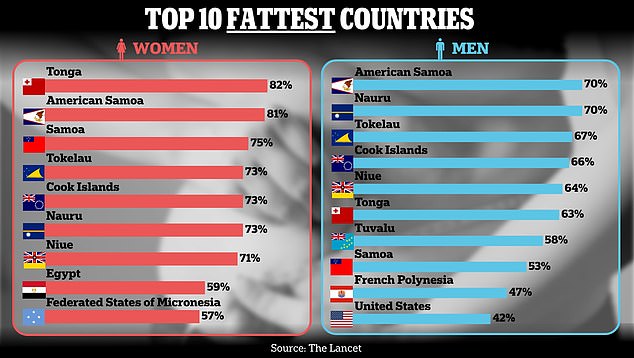The number of people dying from obesity-related diseases such as heart conditions and stroke has increased by 50 per cent in the past 20 years, a major global report has revealed.
In 2000, a high BMI was the 11th leading risk factor for shortening a person’s life. In 2021, it had jumped to sixth place, according to the Global Burden of Disease study, published in the prestigious journal Lancet.
The conditions most commonly suffered by people who die related to obesity include high blood pressure, heart problems, kidney dysfunction, and type 2 diabetes.
However, scientists found that air pollution remains the leading contributor to the global burden of disease in 2021, above obesity.
The places with the highest prevalence of obesity are Tonga, American Samoa, Polynesia and Micronesia, Cook Islands and Niue. The availability of unhealthy foods versus healthy foods is believed to be behind the rising rates of obesity in many island nations.
Dr. Michael Brauer, an affiliate professor at the Institute for Health Metrics and Evaluation (IHME), said the risk factors are becoming more prevalent in young people, but are also “indicative of an aging population that has more chance of developing these conditions over time. ‘
The study, published in The lancetanalyzed data from 204 countries and territories from 1990 to 2021.
Years of healthy life lost and premature death were also due to particulate air pollution, smoking, low birth weight and premature births.
Among the risk factors the researchers analyzed, they found that air pollution was the leading contributor to the global burden of disease in 2021, followed by high blood pressure and smoking.
For younger populations (those aged 14 and under), the greatest risks of poor health and premature death were low birth weight, premature birth, and unsafe water, sanitation, and handwashing.
Meanwhile, for older age groups, high blood pressure, high BMI, high blood sugar levels, and high LDL cholesterol levels had greater impacts on shortening life expectancy.
Between 2000 and 2021, global rates of years lost due to poor health and premature death due to high BMI increased by 16 percent.
This is due to “increasing exposure to risk,” the researchers said, meaning a greater likelihood of someone having a higher BMI, as well as an aging population.
The rise in ultra-processed foods and more sedentary lifestyles is likely to blame.
People’s exposure to the risk of high BMI increased by 1.8 percent annually during the period 2000-2021.
The researchers also said global life expectancy is likely to continue increasing between 2022 and 2050, but at a slower rate.
There were significant decreases in the burden of disease from risk factors related to child and maternal malnutrition, such as stunting, and the rate of years lost due to poor health and premature death decreased by 72 percent between 2000 and 2021. .
For low birth weight and premature births, the rate decreased by 33 percent.

Saudi Arabia, Egypt, Jordan and Turkmenistan are some of the countries with the highest proportion of deaths from obesity

The obesity rate among American adults increased from 21.2 percent in 1990 to 43.8 percent in 2022 for women and from 16.9 percent to 41.6 percent for men.

Between 1990 and 2022, the rate nearly doubled from 11.6 percent to 19.4 percent among American girls and from 11.5 percent to 21.7 percent for boys.
The authors predict that the main reasons for poor health and premature death in 2050 will be heart disease, stroke, diabetes and chronic obstructive pulmonary disease (COPD).
In 2022, the main causes will be heart disease, neonatal disorders, strokes and lower respiratory tract infections.
Previous global data from 2019 found that 13 percent of global deaths were attributable to obesity.
The country with the highest rate was Jordan, with almost a quarter (24 percent) of deaths due to obesity.
About 68 percent of Americans are overweight (BMI between 25 and 30) or obese (BMI over 30).
By comparison, in the United Kingdom, around 64 percent of adults aged 18 and over in England were estimated to be overweight or living with obesity.
While the United States is often thought to be the most obese country in the world, its population of 139 million obese people pales in comparison to China’s 200 million or India’s 350 million.
The obesity rate among American adults increased from 21.2 percent in 1990 to 43.8 percent in 2022 for women and from 16.9 percent to 41.6 percent for men.
In 2000, the obesity rate in the United States was 31 percent.
Another study published in The Lancet this month declared that obesity is a greater health threat than hunger: there are currently one billion overweight people worldwide.
Approximately 159 million children and adolescents and 879 million adults are so high in weight relative to their height that they are classified as obese, the equivalent of approximately one in eight people.
Meanwhile, rates of underweight fell among children and adolescents and more than halved among adults worldwide.


